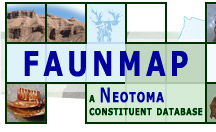


 |
  |
|
POSITIONAL ACCURACY Geographic positions were mostly commonly given in USGS section, township and range or latitude and longitude. When not provided, latitudes and longitudes are those interpolated from the publications that reported the fossil sites. In some cases only a geographic description was given in publications (e.g., the site is located five miles west of Springfield, IL). These descriptions were then transferred to USGS index maps for the 48 states to determine the quadrangle in which the site was located. After determining the quadrangle, the latitude and longitude were taken from the SE corner of the relevant quadrangle and used as the location for the site in the FAUNMAP database. Color coding showing the accuracy of sites is available on the interactive maps. Accuracy is expressed as:
As of 2004 the Landsat images used in the map interface and provided by the JPL WMS service have an offset of 100-200 meters worldwide. JPL was working to fix this but it is unknown when the fix will be completed. |
||
|
|
||